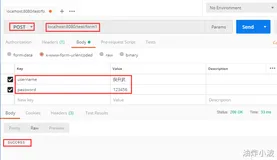|
1
2
3
4
5
6
7
8
9
10
11
12
13
14
15
16
17
18
19
20
21
22
23
24
25
26
27
|
package
com.xxx.training.controller;
import
com.xxx.training.model.User;
import
org.springframework.stereotype.Controller;
import
org.springframework.validation.BindingResult;
import
org.springframework.web.bind.annotation.RequestMapping;
import
org.springframework.web.bind.annotation.RequestMethod;
import
org.springframework.web.servlet.ModelAndView;
import
javax.validation.Valid;
@Controller
@RequestMapping
(value =
"/user"
)
public
class
SignUpController {
@RequestMapping
(value =
"signup"
, method = RequestMethod.POST)
public
ModelAndView signUp(
@Valid
User user, BindingResult result) {
if
(result.hasErrors()) {
return
new
ModelAndView(
"signUpForm"
);
}
return
new
ModelAndView(
"done"
);
}
@RequestMapping
(method = RequestMethod.GET)
public
ModelAndView displaySignUpForm() {
return
new
ModelAndView(
"signUpForm"
,
"user"
,
new
User());
}
}
|
|
1
2
3
4
5
6
7
8
9
10
11
12
13
14
15
16
17
18
19
20
21
22
23
24
25
26
27
28
29
30
|
package
com.xxx.training.model;
import
org.hibernate.validator.constraints.NotEmpty;
import
org.hibernate.validator.constraints.Range;
public
class
User {
@NotEmpty
private
String name;
@Range
(min =
1
, max =
150
)
private
int
age;
public
String getName() {
return
name;
}
public
void
setName(String name) {
this
.name = name;
}
public
int
getAge() {
return
age;
}
public
void
setAge(
int
age) {
this
.age = age;
}
}
|
message.properties
|
1
2
|
NotEmpty.user.name = Name is required!
Range.user.age = Age value must be between
1
and
150
|
signUpForm.jsp
|
1
2
3
4
5
6
7
8
9
10
11
12
13
14
15
16
17
18
19
20
21
22
23
24
25
26
27
28
29
30
31
32
33
34
35
36
37
38
39
40
41
42
|
<%@ taglib prefix=
"form"
uri=
"http://www.springframework.org/tags/form"
%>
<html>
<head>
<style>
.error {
color: #ff0000;
}
.errorblock {
color: #
000
;
background-color: #ffEEEE;
border: 3px solid #ff0000;
padding: 8px;
margin: 16px;
}
</style>
</head>
<body>
<h2>Customer SignUp Form - JSR303
@Valid
example</h2>
<form:form method=
"POST"
commandName=
"user"
action=
"signup"
>
<form:errors path=
"*"
cssClass=
"errorblock"
element=
"div"
/>
<table>
<tr>
<td>Customer Name :</td>
<td><form:input path=
"name"
/></td>
<td><form:errors path=
"name"
cssClass=
"error"
/></td>
</tr>
<tr>
<td>Customer Age :</td>
<td><form:input path=
"age"
/></td>
<td><form:errors path=
"age"
cssClass=
"error"
/></td>
</tr>
<tr>
<td colspan=
"3"
><input type=
"submit"
/></td>
</tr>
</table>
</form:form>
</body>
</html>
|
dispatchServlet-servlet.xml
|
1
2
3
4
5
6
7
8
9
10
11
12
13
14
15
16
17
18
19
20
21
22
23
24
25
26
27
28
29
30
|
<
beans
xmlns="http://www.springframework.org/schema/beans"
xmlns:xsi="http://www.w3.org/2001/XMLSchema-instance"
xmlns:context="http://www.springframework.org/schema/context"
xmlns:mvc="http://www.springframework.org/schema/mvc"
xsi:schemaLocation="http://www.springframework.org/schema/beans
http://www.springframework.org/schema/beans/spring-beans-2.5.xsd
http://www.springframework.org/schema/context
http://www.springframework.org/schema/context/spring-context-2.5.xsd http://www.springframework.org/schema/mvc http://www.springframework.org/schema/mvc/spring-mvc.xsd">
<
context:component-scan
base-package="com.xxx.training"/>
<
bean
id="viewResolver"
class="org.springframework.web.servlet.view.InternalResourceViewResolver">
<
property
name="prefix">
<
value
>/WEB-INF/pages/</
value
>
</
property
>
<
property
name="suffix">
<
value
>.jsp</
value
>
</
property
>
</
bean
>
<!-- support JSR303 annotation if JSR 303 validation present on classpath -->
<
mvc:annotation-driven
/>
<
bean
class="org.springframework.context.support.ResourceBundleMessageSource"
id="messageSource">
<
property
name="basename" value="messages" />
</
bean
>
</
beans
>
|
web。xml:
|
1
2
3
4
5
6
7
8
9
10
11
12
13
14
15
16
17
18
19
20
21
22
23
24
25
26
27
28
29
30
31
32
33
34
35
36
37
38
39
40
41
42
43
44
45
46
47
48
49
50
51
52
53
54
55
56
57
58
59
60
61
|
<?
xml
version="1.0" encoding="UTF-8"?>
<
web-app
version="2.5" xmlns="http://java.sun.com/xml/ns/javaee"
xmlns:xsi="http://www.w3.org/2001/XMLSchema-instance"
xsi:schemaLocation="http://java.sun.com/xml/ns/javaee
http://java.sun.com/xml/ns/javaee/web-app_2_5.xsd">
<
welcome-file-list
>
<
welcome-file
>index.jsp</
welcome-file
>
</
welcome-file-list
>
<
context-param
>
<
param-name
>contextConfigLocation</
param-name
>
<
param-value
>classpath:applicationContext.xml</
param-value
>
</
context-param
>
<
listener
>
<
listener-class
>org.springframework.web.context.ContextLoaderListener</
listener-class
>
</
listener
>
<
servlet-mapping
>
<
servlet-name
>default</
servlet-name
>
<
url-pattern
>*.png</
url-pattern
>
</
servlet-mapping
>
<
servlet-mapping
>
<
servlet-name
>default</
servlet-name
>
<
url-pattern
>*.js</
url-pattern
>
</
servlet-mapping
>
<
servlet-mapping
>
<
servlet-name
>default</
servlet-name
>
<
url-pattern
>*.css</
url-pattern
>
</
servlet-mapping
>
<
servlet
>
<
servlet-name
>dispatcherServlet</
servlet-name
>
<
servlet-class
>org.springframework.web.servlet.DispatcherServlet</
servlet-class
>
<
load-on-startup
>1</
load-on-startup
>
</
servlet
>
<
servlet-mapping
>
<
servlet-name
>dispatcherServlet</
servlet-name
>
<
url-pattern
>/</
url-pattern
>
</
servlet-mapping
>
<
filter
>
<
filter-name
>CharacterEncodingFilter</
filter-name
>
<
filter-class
>org.springframework.web.filter.CharacterEncodingFilter</
filter-class
>
<
init-param
>
<
param-name
>encoding</
param-name
>
<
param-value
>UTF-8</
param-value
>
</
init-param
>
</
filter
>
<
filter-mapping
>
<
filter-name
>CharacterEncodingFilter</
filter-name
>
<
url-pattern
>/</
url-pattern
>
</
filter-mapping
>
<
error-page
>
<
error-code
>404</
error-code
>
<
location
>/WEB-INF/pages/404.jsp</
location
>
</
error-page
>
</
web-app
>
|
==============================================================================
本文转自被遗忘的博客园博客,原文链接:http://www.cnblogs.com/rollenholt/archive/2012/12/27/2836374.html,如需转载请自行联系原作者

